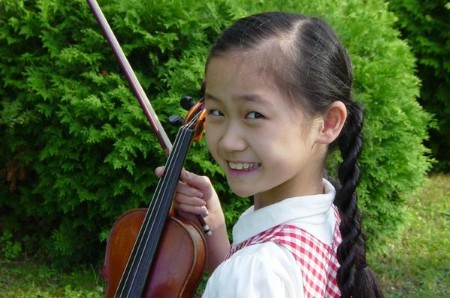Classical Music Review: Winsor Music

Violin virtuoso Yuki Beppu
In Boston’s world of classical music, Winsor Music is indeed a gem; its current director and founder (1996) Peggy Pearson, has done an incredible job pursuing the three dimensions of this organization — chamber music concert series, the commission of new works and a community outreach program engaging talented students in the Boston area. I have followed Peggy’s work for more than five years; I continue to be impressed.
The works on Saturday night’s (November 28) concert were: Brahms: Sonata in F major for cello and piano; Harbison: Chorale Cantata; and J.S. Bach: Concerto in C minor for oboe, violin and strings. The Bach featured the 12-year-old violin virtuoso Yuki Beppu. The venue for this concert could hardly have been better –- this small octagonal church is perfect for the intimacy of chamber music and its acoustics are ideal.
The Cello Sonata is classic, albeit fairly early (mid 1860s) Brahms; it is full of youthful energy while displaying his rich, mature romanticism. The power and sheer emotional energy of performers Rafael Popper-Keizer (cello) and Eliko Akahori (piano) were remarkable.
My main reservation was something that I have noticed in chamber sonata performances in recent years –- the piano is a nine foot concert Steinway grand with the lid fully raised. The piano in this disposition is intended to play with and through a large symphony orchestra, in stark contrast to a chamber sonata with a single solo instrument. What this and like presentations do is to shift how Brahms intended, 150 years ago, a solo cello sonata to sound. Under the current arrangement we no longer have the musical equity of a duet; rather, when the relatively small sounding cello is able to rise to the occasion, we have it accompanying the piano, as was the case in much of Saturday night’s Brahms performance.
There are two additional points consistent with the “Steinway” problem -– 1) musical nuance and delicacy were often sacrificed for bravado of virtuosic speed and volume; 2) at the end of three of the four sonata movements, one had to consciously restrain himself from applauding. While the music of Brahms accommodates this enthusiasm, it is the musicians’ responsibility to perform the work to minimize this inclination; otherwise, the work lacks the appropriate aesthetic arc.
With respect to melding the quality of composition and performance, the Haribson work was clearly the strongest on this program. This ten minute work was commissioned by Peggy Pearson and Dawn Upshaw in 1998. Harbison is a veritable icon of American contemporary music; his work is eminently accessible and serious. I would describe his compositions as being “conservatively post-diatonic,” in contrast to some of the more offensive and aggressive musical styles over the course of the past century.
The Cantata is based upon a Bach setting of a Martin Luther text, to which Harbison adds a poem by Michael Fried. In his introductory remarks composer indicates that he remained closer to the modal nature of the master’s original intent than did Bach himself. Listening to the Harbison, it occurred to me that this was Gregorian chant, filtered through Bach and on steroids. The work begins with a passage of the Bach setting itself, and then goes directly into the Harbison.
The Harbison work was performed by three soloists with string accompaniment. The solo violin (Gabriela Diaz) is less prominent than both the soprano, (Kendra Colton) and the oboe, (Peggy Pearson). The work was performed superbly. The balance between the solos and the accompaniment was appropriate in contrast to the Brahms performance – possibly because Harbison took into account contemporary chamber performance practice. In any case, the performance was very successful.
The Bach Concerto for oboe violin and strings is particularly close to my heart –- I was the oboe novice some 50 years ago when I performed it with the Prof. of violin at the University of Iowa, the summer after I graduated from high school; the experience is permanently etched in my mind.
This is a most precious, small Bach work; it could hardly be more straightforward. Pearson’s interpretation of the work is substantially different from mine, but that is a matter of artistic taste and not a musical shortfall. There is one thing, however, which I feel must be noted –- the “Steinway” problem recurs again and even more severely than in the Brahms. The strings completely overwhelmed the soloists throughout. The criterion regarding the volume here could be the harpsichord; if it cannot be heard, it should not have been included; in order for it to have been heard, the strings would have had to play considerably more softly, which would have resulted with a notable difference in the performance.
Yuki Beppu was simply phenomenal; it is most unfortunate that much of the time she could not be heard.
Whatever my reservations, I left the concert feeling as though I had had a John Dewey moment (to return once more to the 1950s) in the sense that “that was an experience.” This very rarely happens to me, and I am very much in Pearson’s debt for making that happen.
Tagged: Chamber music, Peggy Pearson, William Webstern, Winsor Music
